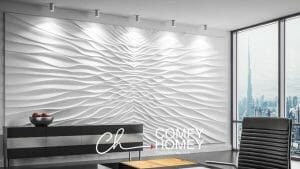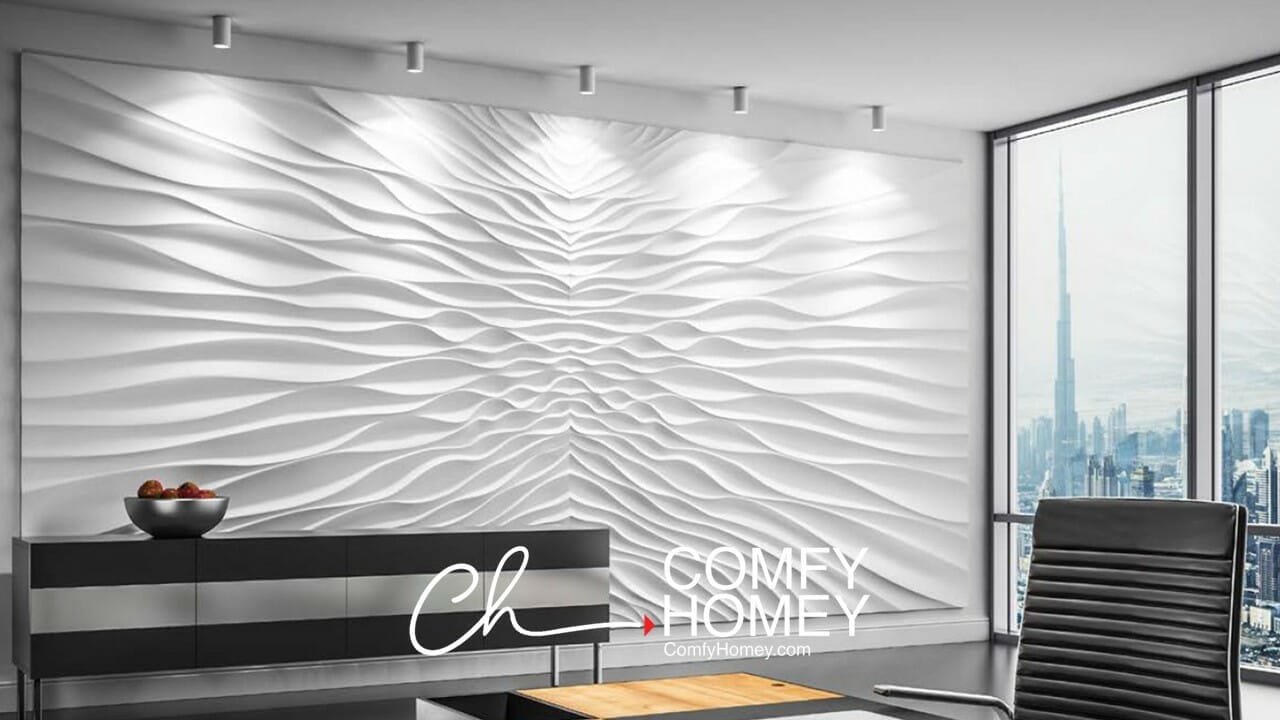Table of Contents
ToggleHave you ever walked into a room and felt an instant sense of awe and admiration because of its stunning walls? If so, chances are those walls were adorned with exquisite wall cladding. Wall cladding in the Philippines is not just about covering up plain surfaces; it’s about transforming them into works of art. So, if you’re ready to take your interior design game to the next level, then keep reading! In this article, we will unveil the secrets behind choosing the perfect wall cladding in the Philippines. Get ready to be inspired by different materials, patterns, and textures that will elevate your space from ordinary to extraordinary!
The Importance of Wall Cladding in the Philippines
Wall cladding plays a crucial role in the architecture and design of buildings in the Philippines. Beyond just being an aesthetic feature, wall cladding in the Philippines provides several practical advantages that make it a valuable addition to any construction project. Firstly, wall cladding helps protect the building from external elements such as rain, heat, and humidity. The Philippines has a tropical climate with high levels of rainfall throughout the year. Therefore, having effective wall cladding is essential to prevent water infiltration and subsequent damage to the structural integrity of the building.
Moreover, wall cladding in the Philippines offers insulation benefits that are particularly important in a country like the Philippines, where temperature fluctuations can be significant throughout the day. The right choice of materials for cladding can help regulate internal temperatures by reducing heat transfer from outside or retaining cool air inside. This not only promotes energy efficiency but also enhances comfort levels for occupants.
Last, wall cladding in the Philippines is a versatile element that can enhance both exterior and interior design aesthetics. From natural stone finishes that exude elegance to sleek modern panels that create a contemporary feel, choosing the perfect surface covering for your walls can elevate your property’s overall appearance.

Types of Wall Cladding Materials Available in the Philippines
One of the most crucial decisions in designing a space is choosing the right wall cladding material. In the Philippines, there are various options available that can enhance the aesthetic appeal and functionality of your walls. One popular choice is ceramic tiles, known for their durability and versatility. Available in an array of colors, textures, and patterns, ceramic tiles can create a stunning feature wall or add visual interest to any room.
Another commonly used material is wood cladding. With its natural beauty and warm tones, wood creates a cozy ambiance that instantly elevates any space. From rustic reclaimed wood to sleek engineered wood panels, you can choose from a wide range of finishes depending on your desired style. Wood cladding not only adds visual appeal but also provides insulation and soundproofing properties.
For those seeking a more industrial or contemporary look, metal cladding might be the perfect option. Steel or aluminum sheets come in various finishes, like brushed or polished, that add modern sophistication to any facade or interior space. Metal cladding offers durability as well as protection against weather elements.
When it comes to choosing wall cladding materials in the Philippines, there are several options to consider depending on your preferred style and functionality requirements. Whether you prefer the timeless elegance of ceramic tiles, the warmth of wood paneling, or the sleekness of metal sheets – each material has its unique qualities that can transform walls into architectural masterpieces while providing added benefits such as insulation or weather protection along the way.

Stone: Wall Cladding Material Available in the Philippines
When it comes to wall cladding materials in the Philippines, stone is an option that cannot be overlooked. With its timeless and elegant appearance, stone adds a touch of luxury to any space. The beauty of stone lies in its natural variations, whether it’s granite, marble, or limestone. Each piece possesses its own unique characteristics and patterns, creating a visually stunning effect on any wall.
One advantage of using stone as a wall cladding material is its durability. Stone has been used for centuries as a building material due to its strength and longevity. It can withstand extreme weather conditions, such as heavy rain or intense heat, without deteriorating or losing its aesthetic appeal. Additionally, stone cladding requires minimal maintenance, making it a hassle-free choice for homeowners looking for long-lasting solutions.
Another benefit of using stone as wall cladding in the Philippines is its versatility in design options. From rustic charm to modern sophistication, there are various types and finishes available that can suit any style preference or architectural concept. Whether you prefer the rough texture of stacked stones or the smooth and polished look of marble tiles, you can create a truly unique statement on your walls with stone cladding.
If you are searching for the perfect wall cladding material in the Philippines that combines beauty and functionality, look no further than stone. Its natural variations provide an unmatched visual appeal, while its durability ensures it stands the test of time. With endless design possibilities available for every style preference, stone cladding offers a versatile solution that will transform your walls into works of art. Whether you prefer a rustic and earthy look or a sleek and modern aesthetic, stone cladding can be customized to suit your personal taste.

Wood: Wall Cladding Material Available in the Philippines
Wood is a classic and timeless choice for wall cladding in the Philippines. Not only does it add warmth and natural beauty to any space, but it also offers excellent durability and longevity. Wood cladding can create a rustic or modern aesthetic, depending on the type of wood used and its finish. From traditional hardwoods like mahogany and narra to sustainable options like bamboo, there are various types of wood available for wall cladding in the Philippines.
One advantage of using wood as a wall cladding material is its versatility. With different species, finishes, and patterns available, you can easily achieve your desired look. For instance, lighter-colored woods like teak or pine can create an airy and beachy feel, perfect for coastal-inspired homes or tropical-themed spaces. On the other hand, dark hardwoods like walnut or cherry provide a luxurious and sophisticated ambiance that can elevate any interior design style.
In addition to its aesthetic appeal, wood also has acoustic properties that make it an ideal choice for office spaces or areas with high noise levels. The natural fibrous structure of wood helps absorb sound waves, reducing echo and creating a more peaceful environment. This makes wood cladding not only visually pleasing but also functional in terms of improving acoustics in a room.
Wood is an excellent choice for wall cladding in the Philippines due to its timeless beauty, durability, aesthetic versatility, and ability to improve acoustics. Whether you prefer a rustic cottage vibe or a sleek modern look, wood cladding can easily be tailored to suit any design preference. With a wide range of wood species available, such as mahogany, teak, and oak, there is a plethora of options to choose from when it comes to achieving your desired aesthetic.

Vinyl: Wall Cladding Material Available in the Philippines
Vinyl is revolutionizing the world of wall cladding in the Philippines. Its versatility and durability make it an excellent choice for both residential and commercial properties. With its wide range of colors, patterns, and styles, vinyl can transform any space into a visual masterpiece.
One of the greatest advantages of vinyl wall cladding is its resistance to moisture and humidity. In a tropical country like the Philippines, where rain is frequent, and humidity levels are high, choosing a material that can withstand these conditions is crucial. Vinyl not only resists water damage but also prevents mold growth, ensuring your walls stay clean and healthy for years to come.
Moreover, vinyl wall cladding offers easy installation and maintenance. It can be quickly installed on any surface without much hassle or mess. The material is easy to clean with just a damp cloth or mop, making it ideal for busy households or commercial spaces that require regular upkeep.
Additionally, vinyl provides excellent insulation properties by acting as a barrier against heat transfer. This means that your interiors will stay cooler during hot seasons while reducing energy consumption from air conditioning units—a win-win situation!
Vinyl wall cladding in the Philippines checks all the boxes when it comes to choosing the perfect material for your walls in the Philippines. From its versatility in design to its resistance against moisture and humidity, vinyl offers numerous benefits that cater specifically to our unique climate conditions. So why settle for anything less when you can have an exquisite and long-lasting solution with vinyl?

Brick: Wall Cladding Material Available in the Philippines
Brick, a popular wall cladding material in the Philippines, offers a timeless and elegant look to any space. Its versatility makes it suitable for both exterior and interior walls, adding character and depth to any design. The natural beauty of brick creates a warm and inviting atmosphere, making it an excellent choice for residential and commercial spaces.
One advantage of using brick as a wall cladding in the Philippines is its durability. Unlike other materials that may fade or deteriorate over time, bricks are known for their strength and longevity. They can withstand harsh weather conditions, such as strong winds and heavy rain, without losing their charm. Brick also requires minimal maintenance, making it a practical choice for busy homeowners or business owners.
In addition to its durability, brick offers numerous design possibilities. With different textures, colors, and patterns available in the market today, homeowners can get creative with their wall cladding choices. Whether you prefer a rustic look or a modern vibe, there is a brick style that will suit your aesthetic preferences perfectly.
If you’re looking for a reliable and stylish wall cladding material in the Philippines that will stand the test of time while adding beauty to your space, consider using brick. Its durability, combined with its design flexibility, makes it an excellent choice for any project. So go ahead and explore the world of brick wall cladding – you won’t be disappointed!

6 Factors to Consider When Choosing Wall Cladding in the Philippines
When it comes to choosing wall cladding in the Philippines, there are a few factors that you should consider. By carefully considering these factors before making your decision on which wall cladding to choose in the Philippines, you can ensure that you have selected an option that not only enhances your space aesthetically but also meets all your practical needs in terms of durability and maintenance.
1. Material of the Wall Cladding in the Philippines
When it comes to choosing the perfect wall cladding for your home in the Philippines, there are several factors to consider. One of the most important factors is the material of the cladding itself. In this tropical country, where extreme heat and heavy rains are common, it’s essential to choose a material that can withstand these conditions.
One popular option for wall cladding in the Philippines is natural stone. Not only does it provide a timeless and elegant look, but it also offers excellent durability. Natural stone is resistant to water damage and can withstand high temperatures without warping or cracking. It also adds a touch of sophistication to any space and can be used both indoors and outdoors.
Another material commonly used for wall cladding in the Philippines is cement fiberboard. This versatile material offers excellent moisture resistance, making it ideal for humid environments. Cement fiberboard is also strong and durable, providing long-lasting protection for your walls. Additionally, it can be easily painted or stained to match any design theme or color scheme.
When choosing wall cladding in the Philippines, considering the material is crucial for ensuring durability and performance against challenging weather conditions. Natural stone provides an elegant aesthetic while being resilient against heat and heavy rains. On the other hand, cement fiberboard offers strength and versatility that suits humid environments well while allowing customization through painting or staining options. By carefully assessing these factors, you can make an informed decision about which type of wall cladding will best suit your needs.

2. Style of Wall Cladding in the Philippines
The style of wall cladding you choose for your home can greatly impact the overall aesthetic and appeal of your property. In the Philippines, there are various factors to consider before making a decision. One important factor is the climate. With its tropical weather, it’s crucial to choose a wall cladding material that can withstand high humidity and intense sunlight without fading or deteriorating over time.
When choosing wall cladding in the Philippines, it’s also essential to take into account the architectural style of your home. Different styles call for different materials – whether it be natural stone for a rustic look or sleek metal panels for a modern aesthetic. Matching the cladding with your home’s style will create an aesthetically pleasing and cohesive design.
Selecting the right style of wall cladding involves careful consideration of climate resilience, maintenance requirements, durability, lifespan, and architectural compatibility. By taking these factors into account when making your decision in the Philippine market, you’ll ensure that your chosen wall cladding not only enhances but also protects your home for years to come.

3. Climate May Affect Wall Cladding in the Philippines
The climate in the Philippines can have a significant impact on the durability and longevity of wall cladding. With its tropical climate characterized by high temperatures and high humidity, it is essential to consider certain factors when choosing wall cladding materials. One key factor to consider is the material’s resistance to moisture. The constant exposure to humidity and moisture can cause some materials, such as wood, to warp or rot over time. Opting for moisture-resistant materials like vinyl or fiber cement can help prolong the lifespan of your wall cladding in the Philippines.
Another crucial factor affected by climate is thermal insulation capabilities. The scorching heat in the Philippines can make homes sweltering hot if they lack proper insulation. Investing in wall cladding materials that are designed for thermal insulation can help regulate indoor temperatures, keeping your home cooler even during scorching summer months. Materials like polystyrene-backed metal panels or energy-efficient composite cladding provide excellent thermal properties while enhancing aesthetic appeal.
Last, considering factors related to intense weather conditions should also be a priority when selecting wall cladding in the Philippines. The country is prone to typhoons and heavy rains, which means that your chosen material should be able to withstand these extreme weather events without getting damaged or compromised easily. Materials like brick, stone veneer, or fiber cement possess durable qualities that make them resistant to wind damage and water infiltration.
When choosing wall cladding in the Philippines, it’s important to consider how it will withstand the local climate conditions in order to ensure its longevity and structural integrity. Additionally, the ability of the wall cladding in the Philippines to provide insulation is another crucial factor to consider. The Philippines experiences high temperatures throughout the year, so selecting a material that offers thermal insulation can help regulate indoor temperatures and reduce energy consumption.

4. Maintenance of Wall Cladding in the Philippines
When choosing wall cladding in the Philippines for your commercial and residential properties, it is important to consider the maintenance requirements of different materials. One factor to consider is the climate in the Philippines, a country known for its tropical weather. Materials such as wood may require regular sealing and painting to protect against moisture and humidity. On the other hand, materials like vinyl or metal cladding may be more resistant to heat and moisture damage, making them easier to maintain in this type of environment.
Another factor to consider is durability. In an area prone to typhoons and heavy rain, it is essential to choose a material that can withstand these harsh weather conditions. Materials like fiber cement or stone veneer are known for their durability while also providing an attractive aesthetic. By selecting a durable material upfront, you can minimize future maintenance needs and ensure that your wall cladding in the Philippines will last for years without extensive repairs or replacements.
Additionally, it’s crucial to think about long-term costs when choosing wall cladding in the Philippines. While some materials may be initially cheaper than others, they may require more frequent maintenance or replacement over time. This can add up in terms of both money and time spent on upkeep. Therefore, considering the long-term cost-effectiveness of different wall cladding options can help you make a well-informed decision.
Overall, when choosing wall cladding in the Philippines, factors such as climate compatibility, durability against extreme weather conditions,and long-term cost-effectiveness are important considerations that should guide your decision-making process.

5. Wall Cladding Aesthetics in the Philippines
When it comes to choosing wall cladding in the Philippines, aesthetics play a crucial role. The right type of cladding can drastically enhance the overall look and feel of a space. One important factor to consider is the architectural style of your home or building. For traditional Filipino-style homes, materials like bamboo or wood can be an excellent choice as they add warmth and natural beauty to the exterior walls. On the other hand, if you have a modern home with sleek lines and minimalistic design, materials like glass, metal, or concrete can create a contemporary and sophisticated look.
Another factor to keep in mind is the color and texture of the wall cladding in the Philippines. Depending on your personal preferences and the desired aesthetic outcome, you may opt for bold colors that make a statement or go for neutrals that provide a more timeless appeal. Texture-wise, options range from smooth finishes for a clean look to textured surfaces for added depth and visual interest.
Lastly, don’t forget about maintenance requirements when choosing wall cladding. Different materials may have varying levels of durability and need differing degrees of upkeep. For instance, while stucco may require periodic repainting due to its susceptibility to moisture damage, fiber cement panels offer low maintenance benefits as they are resistant to rotting, warping, or cracking.
By considering these factors—architectural style, color & texture choices, as well as maintenance requirements—Filipino homeowners can make the right financial and design decisions when it comes to selecting wall cladding in the Philippines that not only enhances their property’s aesthetics but also provides long-lasting protection.

6. Budget When Buying Wall Cladding in the Philippines
When it comes to choosing wall cladding in the Philippines for your office or home, budget is often a primary consideration. It’s important to find a balance between cost and quality that fits within your financial means. One factor to consider is the material of the wall cladding. Different materials have different price ranges, so you’ll need to decide which one aligns best with your budget. For example, natural stone cladding may be more expensive than ceramic or vinyl options.
Another factor to consider is the installation process and labor costs associated with it. Some types of wall cladding in the Philippines require professional installation, which can add significant expenses to your overall budget. On the other hand, there are DIY-friendly options available that can help you save money on installation fees. However, keep in mind that DIY projects come with their own risks and challenges.
Maintenance costs and budget should also be taken into account when choosing wall cladding in the Philippines. While certain materials, like natural stone, may initially seem more costly, they often require less maintenance in the long run compared to cheaper alternatives. This means potentially saving money on future repairs and replacements.
By considering these various factors and finding the right balance between cost and quality, you can ensure that your chosen wall cladding suits both your aesthetic preferences and budget constraints in the Philippines.

Popular Wall Cladding Designs in the Philippines
When it comes to the designs of wall cladding in the Philippines, there are several popular options that can transform any space into a stunning and unique masterpiece. One of the most sought-after designs is marble cladding, which exudes timeless elegance and sophistication. With its natural veining patterns and luxurious appearance, marble cladding adds a touch of opulence to both residential and commercial spaces.
Another popular choice for wall cladding in the Philippines is wood paneling. This design option brings warmth and coziness to any room, making it perfect for creating a rustic or traditional ambiance. Wood paneling can be made from various types of timber, allowing for endless possibilities in terms of color, texture, and grain pattern. Whether you prefer a sleek and modern look or a more vintage aesthetic, wood paneling provides versatility in design.
Aside from marble and wood, another standout option for wall cladding in the Philippines is the use of concrete tiles. Concrete tiles offer durability and an industrial-chic aesthetic that has been gaining popularity in recent years. With their contemporary yet rugged appeal, these tiles instantly add character to any space while also providing excellent insulation properties.
When it comes to choosing a design for your wall cladding in the Philippines, consider options such as marble cladding for timeless elegance, wood paneling for warmth and coziness, or concrete tiles for an industrial-chic look. These popular designs not only enhance the beauty of your walls but also provide functional advantages, depending on your needs. Explore these choices further to create the perfect ambiance for your home or office.

Maintenance and Longevity of Different Wall Cladding
When it comes to choosing the perfect wall cladding in the Philippines for your home, it is essential to consider not only its aesthetics but also its maintenance and longevity. Different types of wall cladding materials require varying levels of upkeep and can have different lifespans.
One popular option in the Philippines is wood cladding, which adds a warm and natural touch to any space. However, wood cladding requires regular maintenance to prevent warping, rotting, and termite infestation. It is important to regularly seal and refinish wood cladding to protect it from moisture and damage caused by harsh weather conditions.
Another commonly used material is stone cladding, which exudes elegance and durability. Stone walls are resistant to fire, pests, and water damage while offering excellent insulation properties. However, proper maintenance, such as regular cleaning using a soft brush or pressure washer, is necessary for keeping stone cladding looking its best over time.
Metal cladding provides a sleek, modern look while offering long-lasting benefits. Aluminum or steel panels are often used for their resistance against weather elements like rainstorms or strong winds. However, metal claddings should be inspected annually for scratches or dents that could affect their performance and appearance.
Each type of wall cladding in the Philippines requires careful consideration of its unique maintenance requirements to ensure longevity. By understanding these factors when choosing the perfect wall cladding, you can make an informed decision that suits both your style preferences and logistical constraints in the long term.

Cost Considerations for Wall Cladding Installation in the Philippines
When it comes to installing wall cladding in the Philippines, cost considerations play a significant role in decision-making. It’s important to carefully evaluate your budget and determine how much you are willing to invest in this project. One of the primary factors that contribute to the overall cost is the material used for cladding. While natural stone and wood may offer an elegant and luxurious aesthetic, they can also be more expensive compared to alternative options such as vinyl or fiber cement. However, it’s essential to weigh not only the initial costs but also factors like maintenance requirements and durability over time.
Another aspect that affects the cost of wall cladding installation in the Philippines is the size of your property. The larger the surface area that needs cladding, the more materials will be required, resulting in higher expenses. Additionally, intricate designs or patterns can increase labor costs, as skilled installers may need more time to complete intricate detailing work accurately. Moreover, if your property requires scaffolding or specialized equipment for installation due to its height or accessibility issues, these additional expenses should also be factored into your budget.
Balancing aesthetics with affordability should ultimately guide your decision-making process when selecting wall cladding for your property.
Considering all these cost considerations ensures that you make an informed choice based on your financial capabilities while achieving a visually appealing and durable outcome. Remember that while initial savings might tempt you towards cheaper alternatives, don’t compromise on quality, as this can lead to future repair costs outweighing any savings made at present.
Summing Up: How to Choose the Perfect Wall Cladding in the Philippines
In conclusion, choosing the perfect wall cladding in the Philippines requires careful consideration of several factors. First, it is important to understand the climate and environment in which the cladding will be installed. Given the country’s tropical climate with high humidity and occasional heavy rainfall, selecting a material that is resistant to moisture is crucial to ensuring durability and longevity.
Second, considering the aesthetic appeal of the cladding is essential. Wall cladding in the Philippines should complement the overall design concept of your space and enhance its visual appeal. Whether you prefer a modern and sleek look or a more rustic and natural finish, there are various options available in terms of textures, colors, and styles.
Furthermore, it is also necessary to evaluate maintenance requirements when choosing wall cladding. Some materials may require regular cleaning or repainting, while others are low-maintenance options that could save time and effort in upkeep.
Ultimately, by taking into account these considerations—climate resistance, aesthetic appeal, and maintenance requirements—you can make an informed financial decision on selecting the perfect wall cladding in the Philippines for your interior and exterior projects. Don’t hesitate to consult professionals or suppliers who specialize in this field, as they can provide valuable insights on products that meet your specific needs. So go ahead and transform your walls with durable and visually stunning wall cladding!















